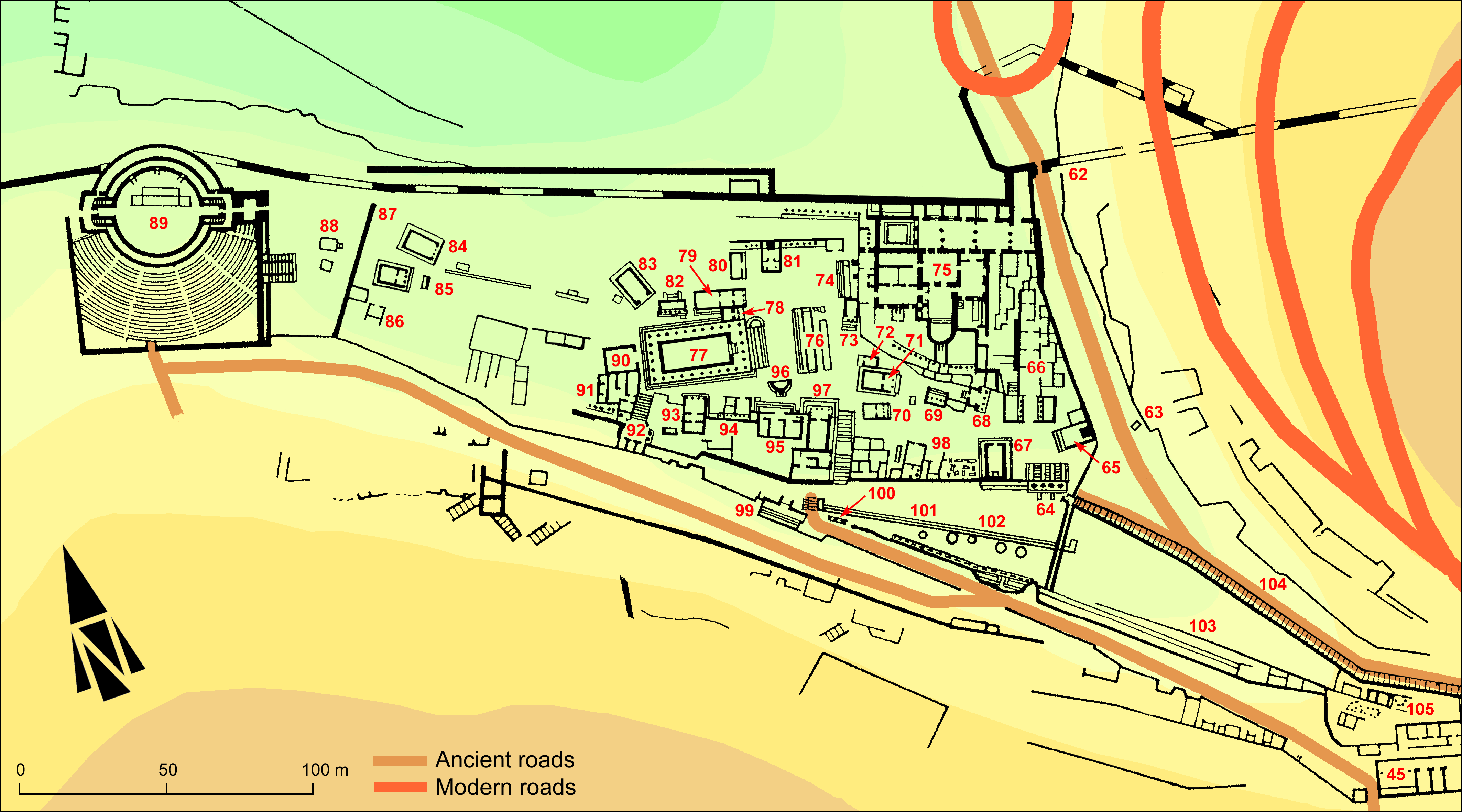Support: White marble base with mouldings, now much worn out, above and below; chipped off at the lower
left angle and on the right edge
(w: 0.65 × h: 0.35 × d: 0.28); a small part has also been lost at the upper right angle since the discovery. A supplementary
line, added above
the inscribed face, is a graffito unrelated to the epigram.
Layout: The main text was inscribed on the whole face (w: 0.52 × h: 0.24) in two columns (hereafter called 'areas') of 10 lines, with
inset for the pentameters; however
there is practically no gap between both columns/areas at ll. 7 and 9.
Letters: 0.012; regularly cut, but now very difficult to read in some parts because of the poor condition of the surface; smaller theta
and omicron, non-slanting sigma, psi with oblique upper strokes, horseshoe omega.
Date: Probably end of second or beginning of first century BC (lettering).
Findspot: Found at an unknown date and anyway before 1979 at
Cyrene ➚:
Sanctuary of Apollo, West of the Strategeion,
where it had probably been re-used.
Place of origin: Cyrene ➚: probably from the
Hellenistic gymnasium which preceded the Caesareum.
Last recorded location:
Seen by C. Dobias-Lalou in 1979 and again in 1985 in its findspot, at Shahat:
West of the Strategeion.
Text constituted from: Transcription from stone (CDL).
French translation
(a) Prince des jeunes gens, un garçon, fils de Dionysios,
est ici célébré à l'attention des hommes par la pierre de marbre ;
c'est que, de tous leurs sabots rapides, ses chevaux lui ont donné
avec son char la victoire parfaite dont il se couronna ;
les sages discours d'Hermès n'ont pas fait défaut dans les enseignements
dont sa patrie l'a nourri au sein de ses brillants gymnases,
non plus que le souci d'Héraclès ; il a donc accompli par la compétition athlétique
des exploits égaux à ceux qui lui vinrent des Muses.
C'est pourquoi —je n'en dis pas plus— à toi, Néôn, délice de Karnèios,
les dieux ouraniens ont accordé un portrait frappé.
(b) Le fils de Theokhrestos, fameux parmi les jeunes gens,
est ici par l'écrit célébré aussi à l'intention des mortels à venir:
loué chez les Muses, choyé d'Hèraklès,
il se couronna de la palme d'une double course de chars,
portant le nom de son aïeul Aristarkhos; en effet son père,
en le nommant, énonça pour son fils le renom ancestral :
"Ah, les [---] sacrés de la Grèce autrefois accomplis !";
Et à son tour il s'élance à travers la mer bleu sombre.
C'est pourquoi depuis longtemps s'est élevée une grande admiration pour toi, [divine Cyrène],
qui nourris de tels fils d'athlètes.
English translation
(a) Prince of the youngsters, a boy, son of Dionysios,
is being celebrated here at the attention of men by the marble stone;
for by means of all their quick hooves, his horses gave him
with his chariot the perfect victory with which he crowned himself;
Hermes' wise discourses were not failing in the education
given by his home-city in its luxurious gymnasiums,
neither was he deprived of Heracles' concern; he thus accomplished through gymnic competition
feats equal to those provided by the Muses.
That is why —be it my last word— you, Neon, Karneios' delight,
was granted by the Ouranian gods a struck image.
(b) The son of Theuchrestos, famous amongst the young men,
is here celebrated through the inscription also for the mortals to come:
praised amongst the Muses, cared for by Heracles,
he crowned himself with the palm of a double chariot race,
wearing the name of his grandfather Aristarchos; indeed his father,
when naming him, spelled for his son the ancestral fame:
'Oh, the sacred [---] of Greece once accomplished!'
And in turn he sets out across the dark blue sea.
That is why a great amazement has long since arisen towards you, [divine Cyrene],
who brings up such sons of athletes.
Italian translation
(a) Principe dei giovani, un ragazzo, figlio di Dionysios,
all’attenzione degli uomini è qui celebrato dalla pietra di marmo;
grazie infatti a tutti i loro zoccoli veloci, i suoi cavalli gli hanno donato
con il cocchio la vittoria perfetta con la quale si è incoronato;
i saggi discorsi di Hermes non sono mancati negli insegnamenti
di cui la patria l'ha nutrito nei suoi splendidi ginnasi,
e nemmeno la cura di Eracle; ha dunque ottenuto
risultati eguali nella competizione atletica e grazie alle Muse.
Per questo – sia la mia ultima parola – a te Neon, delizia di Karneios,
gli dèi urani hanno concesso una immagine coniata.
(b) Il figlio di Theochrestos, illustre tra i giovani,
e qui celebrato dall'iscirizione anche per i mortali a venire,
lodato presso le Muse, accudito da Eracle,
che si è incoronato con la palma di una doppia corsa coi carri,
portando il nome del nonno Aristarchos; perché il padre,
dandogli il nome, determinò per il figlio la fama ancestrale:
“Oh le sacre [---] della Grecia una volta ottenute!”
e [a sua volta] lui si prepara per il cupo mare blu;
per questo da tempo si è levata grande l’ammirazione per te, [divina Cirene],
che allevi tali figli di atleti.



